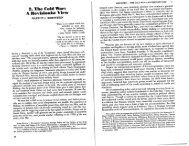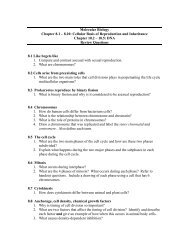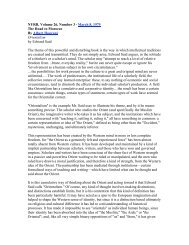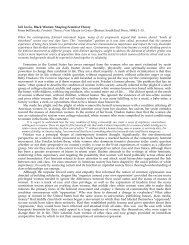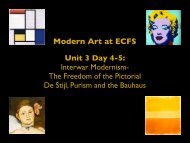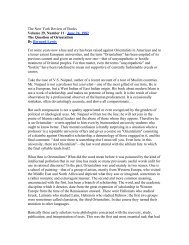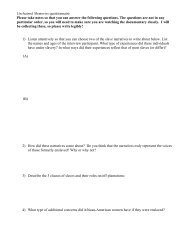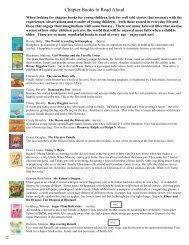fieldston american reader volume i â fall 2007 - Ethical Culture ...
fieldston american reader volume i â fall 2007 - Ethical Culture ...
fieldston american reader volume i â fall 2007 - Ethical Culture ...
- No tags were found...
Create successful ePaper yourself
Turn your PDF publications into a flip-book with our unique Google optimized e-Paper software.
included the Mohawks (People Of the Flint), Oneidas (Peopleof the Stone), Onondagas (People of the Mountain), Cayugas(People at the Landing), and Senecas (Great Hill People),thousands of people bound together by a common Iroquoislanguage.In the vision of the Mohawk chief Hiawatha, the legendaryDekaniwidah spoke to the Iroquois: “We bind ourselves togetherby taking hold of each other’s hands so firmly and forming acircle so strong that If a tree should <strong>fall</strong> upon it, it could notshake nor break it, so that our people and grandchildren shallremain in the circle in security, peace and happiness.”In the villages of the Iroquois, land was owned in commonand worked in common. Hunting was done together, andthe catch was divided among the members of the village.Houses were considered common property and were sharedby several families. The concept of private ownership of landand homes was foreign to the Iroquois. A French Jesuit priestwho encountered them in the 1650s wrote: “No poorhouses areneeded among them, because they are neither mendicants norpaupers.... . Their kindness, humanity and courtesy not onlymakes them liberal with what they have, but causes them topossess hardly anything except in common.”Women were important and respected in Iroquois society.Families were matrilineal. That is, the family line wentdown through the female members, whose husbands joinedthe family, while sons who married then joined their wives’families. Each extended family lived in a “long house.” Whena woman wanted a divorce, she set her husband’s things outsidethe door.Families were grouped in clans, and a dozen or more clansmight make up a village. The senior women in the villagenamed the men who represented the clans at village and tribalcouncils. They also named the forty-nine chiefs who were theruling council for the Five Nation confederacy of the Iroquois.The women attended clan meetings, stood behind the circle ofmen who spoke and voted, and removed the men from office ifthey strayed too far from the wishes of the women.The women tended the crops and took general charge of villageaffairs while the men were always hunting or fishing. And sincethey supplied the moccasins and food for warring expeditions,they had some control over military matters. As Gary B. Nashnotes in his fascinating study of early America, Red, White,and Black: “Thus power was shared between the sexes and theEuropean idea of male dominancy and female subordination inall things was conspicuously absent in Iroquois society.”Children in Iroquois society, while taught the cultural heritageof their people and solidarity with the tribe, were also taught tobe independent, not to submit to overbearing authority. Theywere taught equality in status and the sharing of possessions.The Iroquois did not use harsh punishment on children; theydid not insist on early weaning or early toilet training, butgradually allowed the child to learn self-care.All of this was in sharp contrast to European values as broughtover by the first colonists, a society of rich and poor, controlledby priests, by governors, by male heads of families. Forexample, the pastor of the Pilgrim colony, John Robinson, thusadvised his parishioners how to deal with their children: “Andsurely there is in all children a stubbornness, and stoutnessof mind arising from natural pride, which must, in the firstplace, be broken and beaten down; that so the foundation oftheir education being laid in humility and tractable-ness, othervirtues may, in their time, be built thereon.”Gary Nash describes Iroquois culture:No laws and ordinances,sheriffs and constables, judges and juries, or courts or jails—the apparatus of authority in European societies—were to befound in the northeast woodlands prior to European arrival.Yet boundaries of acceptable behavior were firmly set. Thoughpriding themselves on the autonomous individual, the Iroquoismaintained a strict sense of right and wrong. . . . He who stoleanother’s food or acted invalourously in war was “shamed” byhis people and ostracized from their company until he hadatoned for his actions and demonstrated to their satisfactionthat he had morally purified himself.Not only the Iroquois but other Indian tribes behaved the sameway. In 1635, Maryland Indians responded to the governor’sdemand that if any of them killed an Englishman, the guiltyone should be delivered up for punishment according toEnglish law. The Indians said:It is the manner amongst us Indians, that if any such accidenthappen, wee doe redeeme the life of a man that is so slaine,with a 100 armes length of Beades and since that you are heerestrangers, and come into our Countrey, you should ratherconform yourselves to the Customes of our Countrey, thanimpose yours upon us. .So, Columbus and his successors were not coming into anempty wilderness, but into a world which in some places wasas densely populated as Europe itself, where the culture wascomplex, where human relations were more egalitarian than inEurope, and where the relations among men, women, children,and nature were more beautifully worked out than perhaps anyplace in the world.They were people without a written language, but with theirown laws, their poetry, their history kept in memory andpassed on, in an oral vocabulary more complex than Europe’s,accompanied by song, dance, and ceremonial drama. They paidcareful attention to the development of personality, intensityof will, independence and flexibility, passion and potency, totheir partnership with one another and with nature.87



